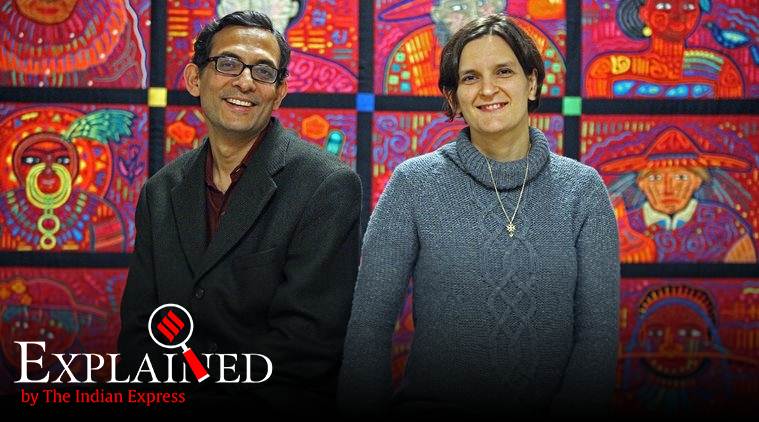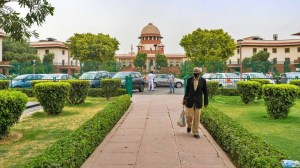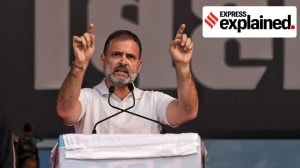- India
- International
Explained: The fingerprints of Nobel Laureate couple on novel pollution-check mechanism in Gujarat
J-PAL has been supporting the pilot ETS scheme, where 155 units in Surat are trading particulate matter in a region where air pollution levels are high. The ETS scheme is aimed at reducing pollution, and at the same time minimising the cost of compliance for the industry.
 Nobel Laureates Abhijit Banerjee and Esther Duflo
Nobel Laureates Abhijit Banerjee and Esther Duflo
Nobel Laureates Abhijit Banerjee and Esther Duflo’s Abdul Latif Jameel Poverty Action Lab (J-PAL) is one of the primary agencies working on a novel Emission Trading Scheme (ETS) — the first of its kind in the world — which was launched a month ago in Surat, Gujarat.
J-PAL has been supporting the pilot ETS scheme, where 155 units in Surat are trading particulate matter in a region where air pollution levels are high.
The ETS scheme is aimed at reducing pollution, and at the same time minimising the cost of compliance for the industry. While trading mechanisms for pollution control do exist in many parts of the world, none of them is for particulate matter emissions.
For example, the CDM (carbon development mechanism) under the Kyoto Protocol allows trade in ‘carbon credits’; the European Union’s Emission Trading System is for greenhouse gas emission; and India has a scheme run by the Bureau of Energy Efficiency that enables trading in energy units.
Explained | Why Abhijit Banerjee, Esther Duflo and Michael Kremer won
What is the Gujarat scheme supported by J-PAL?
The Emissions Trading Scheme (ETS) is a regulatory tool aimed at reducing the pollution load in an area, and at the same time minimising the cost of compliance for the industry. ETS is a market in which the traded commodity is particulate matter emissions. The Gujarat Pollution Control Board (GPCB) sets a cap on the total emission load from all industries. Various industries can buy and sell the ability to emit particulate matter, by trading permits (in kilograms) under this cap. For this reason, ETS is also called a cap-and-trade market.
How many industrial units are participating in ETS?

Live trading began last month, with 88 industries taking part in the first round, out of the 155 that have joined ETS so far. Emission permits worth Rs 2.78 lakh were traded. These industries are from sectors including textiles, chemicals and sugar, and spread over an area of 50-30 sq km.
Abhijit Banerjee: MIT professor whose work on poverty alleviation won him a Nobel
These industries use either coal or bagasse (residue after juice is extracted from sugarcane) as fuel, thus emitting a high amount of ash. The participants were selected on the basis of the size of their chimneys — those with a diameter of 24 inches or more.
Why was Surat chosen for the scheme?
In the last five years, the quality of air in Surat has deteriorated. In 2013, when the project was conceptualised, the PM10 level at Air India Building in Surat was 86 micrograms per cubic metre. According to GPCB annual reports, pollution levels have increased between 120-220 per cent, with PM10 in 2018 reaching 189 µg/cu. m at Air India Building, 282 µg/cu. m at Sachin Industrial Estate and 261 µg/cu. m at Garden Silk Mills.
Surat was chosen because its industrial associations agreed to run the pilot scheme, said officials associated with the project. Also, industries in Surat had already installed Continuous Emission Monitoring Systems, which makes it possible to estimate the mass of particulate matter being released.
How does the trading take place?
At the beginning of every one-month compliance period (during which one emission permit is valid), 80% of the total cap of 280 tonnes for that period is distributed free to all participant units. These permits are allocated based on an industry’s emission sources (boilers, heaters, generators) as this determines the amount of particulate matter emitted. GPCB will offer the remaining 20% of the permits during the first auction of the compliance period, at a floor price of Rs 5 per kilogram. Participating units may buy and sell permits among each other during the period. The price is not allowed to cross a ceiling of Rs 100 per kilogram or fall below Rs 5 per kg, both of which may be adjusted after a review.
How are the auctions conducted?
These take place on the ETS-PM trading platform hosted by the National Commodities and Derivatives Exchange e-Markets Limited (NeML). All participants must register a trading account with NeML. Transactions are linked to the bank accounts of the users, who can view updates through these accounts.
There are two types of auctions. In the Uniform Price Auction every Tuesday between 3 and 5 pm, the week’s permit price is discovered by participating members through bidding. Second, there is a continuous market between Wednesday and Monday (2 pm to 5 pm) where members buy and sell permits, whose prices were fixed on Tuesday.
EXPRESS OPINION
Apr 25: Latest News
- 01
- 02
- 03
- 04
- 05









































